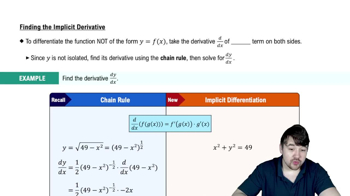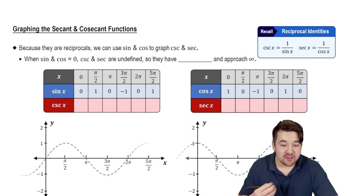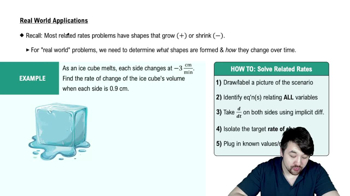Table of contents
- 0. Functions7h 52m
- Introduction to Functions16m
- Piecewise Functions10m
- Properties of Functions9m
- Common Functions1h 8m
- Transformations5m
- Combining Functions27m
- Exponent rules32m
- Exponential Functions28m
- Logarithmic Functions24m
- Properties of Logarithms34m
- Exponential & Logarithmic Equations35m
- Introduction to Trigonometric Functions38m
- Graphs of Trigonometric Functions44m
- Trigonometric Identities47m
- Inverse Trigonometric Functions48m
- 1. Limits and Continuity2h 2m
- 2. Intro to Derivatives1h 33m
- 3. Techniques of Differentiation3h 18m
- 4. Applications of Derivatives2h 38m
- 5. Graphical Applications of Derivatives6h 2m
- 6. Derivatives of Inverse, Exponential, & Logarithmic Functions2h 37m
- 7. Antiderivatives & Indefinite Integrals1h 26m
- 8. Definite Integrals4h 44m
- 9. Graphical Applications of Integrals2h 27m
- 10. Physics Applications of Integrals 2h 22m
4. Applications of Derivatives
Related Rates
Problem 99
Textbook Question
Resistors connected in parallel If two resistors of R₁ and R₂ ohms are connected in parallel in an electric circuit to make an R-ohm resistor, the value of R can be found from the equation
1/R = 1/R₁ + 1/R₂
<IMAGE>
If R₁ is decreasing at the rate of 1ohm/sec and R₂ is increasing at the rate of 0.5 ohm/sec, at what rate is R changing when R₁ = 75 ohms and R₂ = 50 ohms?
 Verified step by step guidance
Verified step by step guidance1
Start by understanding the given equation for resistors in parallel: \( \frac{1}{R} = \frac{1}{R_1} + \frac{1}{R_2} \). This equation relates the total resistance \( R \) to the individual resistances \( R_1 \) and \( R_2 \).
Differentiate both sides of the equation with respect to time \( t \) to find the rate of change of \( R \). Use implicit differentiation: \( \frac{d}{dt} \left( \frac{1}{R} \right) = \frac{d}{dt} \left( \frac{1}{R_1} + \frac{1}{R_2} \right) \).
Apply the chain rule to differentiate: \( -\frac{1}{R^2} \frac{dR}{dt} = -\frac{1}{R_1^2} \frac{dR_1}{dt} - \frac{1}{R_2^2} \frac{dR_2}{dt} \).
Substitute the given rates of change: \( \frac{dR_1}{dt} = -1 \) ohm/sec (since \( R_1 \) is decreasing) and \( \frac{dR_2}{dt} = 0.5 \) ohm/sec (since \( R_2 \) is increasing).
Substitute the given values \( R_1 = 75 \) ohms and \( R_2 = 50 \) ohms into the differentiated equation to solve for \( \frac{dR}{dt} \), the rate at which \( R \) is changing.
 Verified video answer for a similar problem:
Verified video answer for a similar problem:This video solution was recommended by our tutors as helpful for the problem above
Video duration:
7mPlay a video:
Was this helpful?
Key Concepts
Here are the essential concepts you must grasp in order to answer the question correctly.
Related Rates
Related rates involve finding the rate at which one quantity changes in relation to another. In this problem, we need to determine how the equivalent resistance R changes over time as the individual resistances R₁ and R₂ change. This requires applying the chain rule from calculus to relate the rates of change of R₁, R₂, and R.
Recommended video:

Intro To Related Rates
Implicit Differentiation
Implicit differentiation is a technique used to differentiate equations that define one variable in terms of another without explicitly solving for one variable. In this case, we will differentiate the equation 1/R = 1/R₁ + 1/R₂ with respect to time to find the rate of change of R, using the known rates of change of R₁ and R₂.
Recommended video:

Finding The Implicit Derivative
Reciprocal Functions
Reciprocal functions are functions of the form f(x) = 1/x, which have unique properties, especially in calculus. The equation for resistors in parallel involves reciprocal relationships, and understanding how to differentiate these functions is crucial for solving the problem. The behavior of these functions, particularly their rates of change, will play a key role in determining how R changes as R₁ and R₂ vary.
Recommended video:

Graphs of Secant and Cosecant Functions
Related Videos
Related Practice





